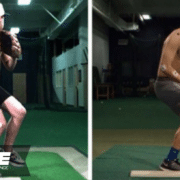Vest Cooling For The Baseball Catcher
In the game of baseball, most of the attention is focused on the pitcher. We are always continuing to research multiple avenues on how to enhance performance for the baseball pitcher. But what about the guy behind the dish?
Catchers are often beaten and scarred at the end of regulation play. Speaking from experience, catching for a doubleheader in the middle of the summer heat is difficult.
Is there a way we can optimize performance for the baseball catcher during a game?
Could it be as simple as staying hydrated, regulating body temperature to prevent heat exhaustion, or wearing an ice vest?
A recent study looked at the effects of intermittent vest cooling on increasing in-game performance for baseball catchers.
Since the game of baseball is mostly played during the hottest months of the year, the use of vest cooling may decrease perceived physical exertion, recovery heart rate, and core body temperature.
This study showed that the use of vest cooling for 4-minutes between innings in simulated games decreased core temperature, cardiovascular strain, and perceived exertion.
The subjects in this study who used the vest cooling also saw a greater perceived recovery status, meaning that they felt more recovered throughout the game.
But couldn’t ice reduce the amount of activity of your working muscles? The 4-minute interval between innings showed no negative effects on muscle temperature and body awareness!
Reducing core temperature and cardiovascular strain during competition allows for the player to increase the amount of work performed.
However, future research is needed to fully understand the mechanisms of intermittent vest cooling for baseball performance.
In this study, subjects only performed catching a fixed number of pitches during a simulated game and were not asked to hit or run the bases, as this would result in an increase in total work performed.
As a rule of thumb, I would give the baseball catcher a quick checklist throughout the game:
- Am I hydrated enough?
- Am I able to take deep breaths between innings and get my heart rate down?
- Is there a bag of ice readily available in the dugout if I feel overheated?
As we learn more, using a cooling vest seems like it may have a future in the game.
Bishop, SH, Szymanski, DJ, Ryan, GA, Herron, RL, and Bishop, PA. The effect of intermittent vest cooling on thermoregulation and cardiovascular strain in baseball catchers. J Strength Cond Res 31(8): 2060–2065, 2017—Baseball catchers are exposed to multiple physiological challenges while playing out- side during the spring and summer months, many of which deal with recovery and thermoregulation. The purpose of this study was to investigate the effect of intermittent cooling on core temperature, cardiovascular strain, exertion, and recovery during a simulated catching performance in the heat. Six trained college-aged baseball catchers performed in a controlled, hot (358º C), and humid (25% relative humidity) environment in a counter-balanced, cross-over design. Ice vest cooling (VC) was used as a cooling modality and was compared with a control of no cooling (NC). Rectal temperature (Tre), heart rate (HR), rating of perceived exertion (RPE), and perceived recovery scale (PRS) were recorded before and after each simulated inning. All activities took place in a heat chamber, and each inning consisted of catchers receiving 12 pitches in their position followed by 6 minutes of recovery. Nine total innings were performed, and 27 total innings were performed with each of the 2 treatments. A significantly smaller mean Tre change was seen in VC when compared with NC (0.58 ± 0.28° C, 0.98 ± 0.28° C, p ≤ 0.01, respectively). Rating of perceived exertion was significantly lower and PRS was significantly improved for VC compared with NC (both p ≤ 0.05). Mean recovery HR during VC was significantly lower than NC in the fifth (VC = 84 ± 8 b*min-1, NC = 90 ± 9 b*min-1, p = 0.04), seventh (VC = 84 ± 3 b*min-1, NC = 92 ± 7 b*min-1, p=0.02), and ninth (VC = 85 ± 7 b*min-1, NC = 93 ± 5 b*min-1, p = 0.01) innings. Heart rate during catching was significantly lower at the end of the VC trials when compared with NC (108 ± 16 b*min-1 vs. 120 ± 19 b*min-1, p = 0.02, respectively). Vest cooling decreased heat strain, cardiovascular strain, and RPE while it improved perceived recovery in catchers over a simulated 3-game series performed in hot conditions.
Jarad Vollkommer
Latest posts by Jarad Vollkommer (see all)
- Strength-Speed: Customized Mechanics for Baseball Pitchers - August 20, 2019
- Determining Individual Stability Needs for the Baseball Player - June 25, 2019
- In-Season Training Metrics for the Baseball Player - March 5, 2019










Leave a Reply
Want to join the discussion?Feel free to contribute!